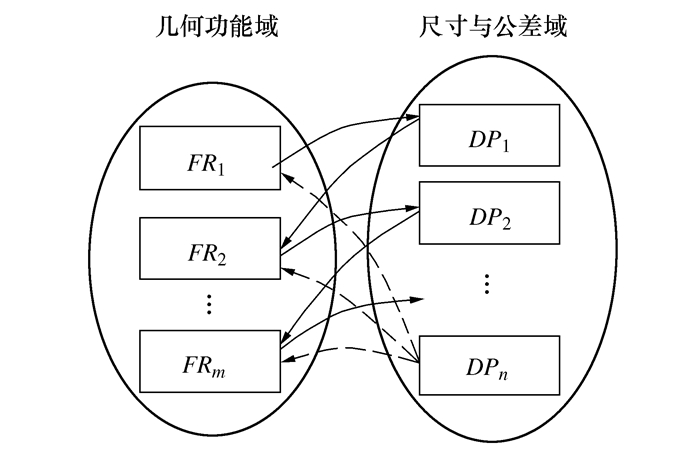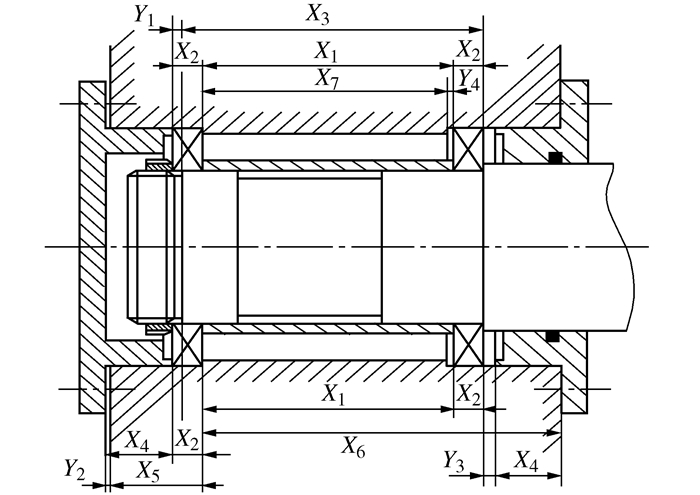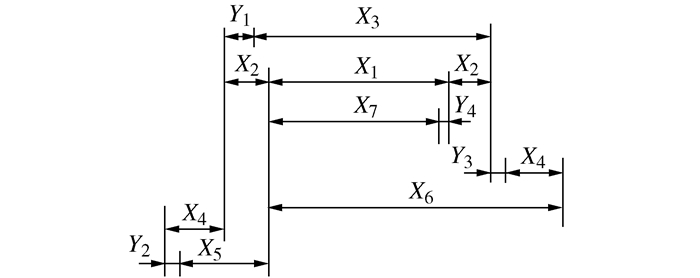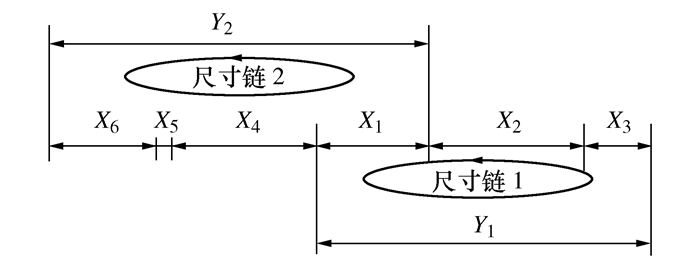Preliminary Study on Application of Axiomatic Design in Tolerance Design
-
摘要: 公差设计依赖于设计人员的经验、缺乏科学设计理论指导;产品公差设计通常为多功能需求设计,且功能需求之间往往又存在耦合,需要分析和解耦;功能方程组(功能需求与功能尺寸之间建立的函数方程组)的求解存在不同的求解策略,需确定最佳的求解策略。针对此类问题,引入公理设计理论至公差设计领域,首先将公差设计过程看作是功能域-尺寸与公差域的映射,利用独立公理和信息公理等来理解和分析公差设计问题,提高公差设计的科学性;其次,以轴承座装配为例分析了如何利用独立公理指导公差耦合设计的求解;最后,以齿轮组装配公差设计为例分析了独立公理和信息公理在解耦设计和判断求解顺序中的应用。研究结果表明,公理设计的引入可为公差设计提供理论框架和逐步分解、展开的机制,辅助判断和求解耦合设计问题,为公差设计理论由经验设计变为科学设计提供了有益的启示。Abstract: Tolerance design depends on an experience of designers for its lack of guidance of scientific design theory. Product tolerance design was usually a multi-functional requirements design. There was often a coupling between functional requirements, and it needs to be analyzed and decoupled. Because there existed different solution strategies, it needed to determine the best solution to solve the function equations, which were established to meet the geometrical functional requirements. In view of these problems, the theory of axiomatic design was firstly introduced to the field of tolerance design. The tolerance design process was seen as mapping from function domain to dimensions and tolerances domain. The independent axiom and information axiom were used for understanding and analyzing the tolerance design, which can improve its scientific meaning of tolerance design. Secondly, the bearing seat assembly was taken as an example to explain the solution of the tolerance decoupling design by using the independence axiom. Finally, the decoupling design and the solving sequence of tolerance allocation of gear assembly are taken as an example to explain the application of independence axiom and information axiom. It shows that the introduction of axiomatic design can provide a framework and mechanism for gradually decomposing the tolerance design, and assist in judging and solving coupling design problems. It provides a useful inspiration for tolerance design theory from experience design to scientific design.
-
Key words:
- tolerance design /
- tolerance design function /
- axiomatic design /
- coupling design
-
图 2 轴承座装配示图[16]
表 1 按策略1求解尺寸链1
名称 基本尺寸 Y1=76 X1=28 X2=40 X3=8 封闭环公差 0.2 比例因子 k=0.2/76 计算公式 kX1 kX2 kX3 组成环公差 0.074 0.105 0.021 表 2 按策略1求解尺寸链2
名称 基本尺寸 Y2=80 X1=28 X4=34 X5=2 X6=16 封闭环公差 0.16 预设公差 0.074 比例因子 k=(0.16-0.074)/(80-28) 计算公式 kX4 kX5 kX6 组成环公差 0.056 0.003 0.027 表 3 按策略2求解尺寸链2
名称 基本尺寸 Y2=80 X1=28 X4=34 X5=2 X6=16 封闭环公差 0.16 比例因子 k=0.16/80 计算公式 kX1 kX4 kX5 kX6 组成环公差 0.056 0.068 0.004 0.032 表 4 按策略2求解尺寸链1
名称 基本尺寸 Y1=76 X1=28 X2=40 X3=8 封闭环公差 0.2 预设公差 0.056 比例因子 k=(0.2-0.056)/(76-28) 计算公式 kX2 kX3 组成环公差 0.120 0.024 -
[1] 杨将新.基于装配成功率的公差优化设计系统研究[D].杭州: 浙江大学, 1996Yang J X. Study on tolerance optimization design system based on assembly success ratio[D]. Hangzhou: Zhejiang University, 1996(in Chinese) [2] 卢军, 赵丽萍.基于知识的公差设计[J].计算机集成制造系统, 2001, 7(11):50-53 doi: 10.3969/j.issn.1006-5911.2001.11.010Lu J, Zhao L P. A design method of tolerance allocation based on knowledge[J]. Computer Integrated Manufacturing Systems, 2001, 7(11):50-53(in Chinese) doi: 10.3969/j.issn.1006-5911.2001.11.010 [3] Suh N P. Axiomatic design:advances and applications[M]. New York:Oxford University Press, 2001 [4] 朱龙英, 朱如鹏, 刘正埙.公理化设计与质量功能配置集成研究[J].机械科学与技术, 2004, 23(6):647-650 doi: 10.3321/j.issn:1003-8728.2004.06.006Zhu L Y, Zhu R P, Liu Z X. Study on integrated axiomatic design and quality function deployment (QFD)[J]. Mechanical Science and Technology, 2004, 23(6):647-650(in Chinese) doi: 10.3321/j.issn:1003-8728.2004.06.006 [5] 肖人彬, 蔡池兰, 刘勇.公理设计的研究现状与问题分析[J].机械工程学报, 2008, 44(12):1-11 http://d.old.wanfangdata.com.cn/Periodical/jxgcxb200812001Xiao R B, Cai C L, Liu Y. Current research situation and problem analysis of axiomatic design[J]. Chinese Journal of Mechanical Engineering, 2008, 44(12):1-11(in Chinese) http://d.old.wanfangdata.com.cn/Periodical/jxgcxb200812001 [6] 程强, 刘志峰, 蔡力钢, 等.基于公理设计的产品平台规划方法[J].计算机集成制造系统, 2010, 16(8):1587-1596 http://d.old.wanfangdata.com.cn/Periodical/jsjjczzxt201008003Cheng Q, Liu Z F, Cai L G, et al. Planning method for product platform based on axiomatic design[J]. Computer Integrated Manufacturing Systems, 2010, 16(8):1587-1596(in Chinese) http://d.old.wanfangdata.com.cn/Periodical/jsjjczzxt201008003 [7] Kulak O, Cebi S, Kahraman C. Applications of axiomatic design principles:A literature review[J]. Expert Systems with Applications, 2010, 37(9):6705-6717 doi: 10.1016/j.eswa.2010.03.061 [8] Islam M N. A strategy for solving coupled functional equations[J]. The International Journal of Advanced Manufacturing Technology, 2004, 24(7-8):461-468 doi: 10.1007/s00170-002-1436-6 [9] Islam M N. A dimensioning and tolerancing methodology for concurrent engineering applications Ⅰ:problem representation[J]. The International Journal of Advanced Manufacturing Technology, 2009, 42(9-10):910-921 doi: 10.1007/s00170-008-1649-4 [10] Anselmetti B. Generation of functional tolerancing based on positioning features[J]. Computer-Aided Design, 2006, 38(8):902-919 doi: 10.1016/j.cad.2006.05.005 [11] 钟艳如, 王冰清, 黄美发, 等.基于描述逻辑的功能公差分析[J].计算机集成制造系统, 2015, 21(8):2004-2013 http://d.old.wanfangdata.com.cn/Periodical/jsjjczzxt201508005Zhong Y R, Wang B Q, Huang M F, et al. Functional tolerance analysis based on description logic[J]. Computer Integrated Manufacturing Systems, 2015, 21(8):2004-2013(in Chinese) http://d.old.wanfangdata.com.cn/Periodical/jsjjczzxt201508005 [12] 杨波, 杨涛, 昃向博.生长型设计中的功能公差设计理论[J].机械工程学报, 2006, 42(10):73-79 doi: 10.3321/j.issn:0577-6686.2006.10.013Yang B, Yang T, Ze X B. Function tolerance theory in incremental growth design[J]. Chinese Journal of Mechanical Engineering, 2006, 42(10):73-79(in Chinese) doi: 10.3321/j.issn:0577-6686.2006.10.013 [13] Srinivasan R S, Wood K L, McAdams D A. Functional tolerancing:A design for manufacturing methodology[J]. Research in Engineering Design, 1996, 8(2):99-115 http://d.old.wanfangdata.com.cn/OAPaper/oai_doaj-articles_235e4a99c8a6f5a2310a5f42193abe5f [14] Gaunet D. 3D Functional tolerancing & annotation: CATIA tools for geometrical product specification[M]//Bourdet P, Mathieu L. Geometric Product Specification and Verification: Integration of Functionality. Dordrecht: Springer, 2003: 25-33 [15] Lindkvist L, SÖDerberg R. Computer-aided tolerance chain and stability analysis[J]. Journal of Engineering Design, 2003, 14(1):17-39 doi: 10.1080/0954482031000078117 [16] Fradinho J, Mourão A, Gabriel-Santos A, et al. An axiomatic design interpretation for the synthesis of dimensional tolerances[J]. Procedia CIRP, 2016, 53:89-94 doi: 10.1016/j.procir.2016.07.003 [17] 中华人民共和国国家质量监督检验检疫总局, 中国国家标准化管理委员会.GB/T1800.1-2009产品几何技术规范(GPS)极限与配合第1部分: 公差、偏差和配合的基础[S].北京: 中国标准出版社, 2009General Administration of Quality Supervision, Inspection and Quarantine of the People's Republic of China, Standardization Administration of China. GB/T 1800.1-2009 Geometrical product specifications (gps)-limits and fits-Part 1: bases of tolerances deviations and fits[S]. Beijing: Standards Press of China, 2009(in Chinese) -








 下载:
下载:





